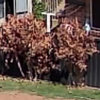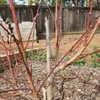Dr. Rogers,
Over the last half-dozen years I've piecewise experimented with a number of turfgrasses in our moderately shady and often damp backyard. The yard as we received it was a mix of fine fescue, poa triv, and a bit of Kentucky bluegrass in the sunnier portions.
Several years ago I planted 1k sq. ft. to poa supina, and it was doing well until my wife and children decided they didn't like the color, so it got glyphosated (except for one plant that I spared, which is now a nice dense patch). Most of the rest of the yard has been seeded to tall fescue, which has done okay, but I'm sick of the big outbreaks of gray snow mold each March. I've sent some good pictures of this to Kevin Frank--he uses them in presentations--so my yard is now infamous!
Through the last couple years I've noticed that the remnant bits of poa triv have really gone wild. They have spread quite a bit and look really robust in early Spring and lat Fall. Of course they look terrible in July and August. My question is this: Is the fact that poa triv does so well in my backyard a reliable indicator that poa supina would also thrive there? When it comes to lawn matters, I retain veto power over the rest of the family.
By the way, a few weeks ago I bought "Lawn Geek" and consider it to be an excellent book. See you at field day.
A.J.








yarddoctor
yysc2_aol_com
Related Discussions
Who seeded poa trivialis?
Q
Certainty herbicide for Poa Trivialis
Q
Poa Annua (& Poa Trivialis)
Q
Poa Trivialis Source
Q